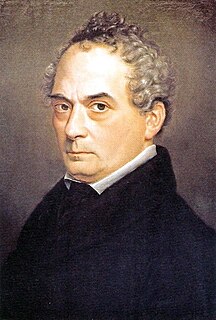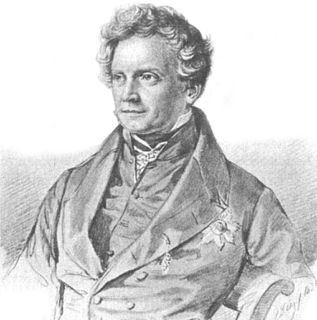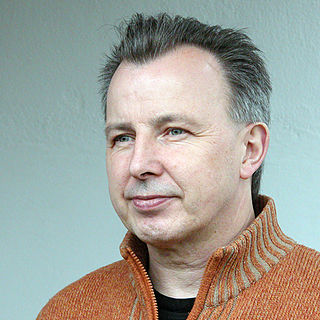Related Research Articles

Clemens Wenzeslaus Brentano was a German poet and novelist, and a major figure of German Romanticism. He was the uncle, via his brother Christian, of Franz and Lujo Brentano.

Karl August Varnhagen von Ense was a German biographer, diplomat and soldier.

Wilhelm Scherer was a German philologist and historian of literature. He was known as a positivist because he based much of his work on "hypotheses on detailed historical research, and rooted every literary phenomenon in 'objective' historical or philological facts". His positivism is different due to his involvement with his nationalist goals. His major contribution to the movement was his speculation that culture cycled in a six-hundred-year period.
Dietrich Heinrich Freiherr von Bülow (1757–1807) was a Prussian soldier and military writer, and brother of General Count Friedrich Wilhelm Bülow.

Ricarda Huch was a pioneering German intellectual. Trained as an historian, and the author of many works of European history, she also wrote novels, poems, and a play. Asteroid 879 Ricarda is named in her honour. She was nominated for the Nobel Prize in Literature seven times.

Joseph Hirsch (Tzvi) Carlebach was an Orthodox rabbi and Jewish-German scholar and natural scientist (Naturwissenschaftler).

Max Herbert Eulenberg (1876–1949), was a German poet and author born in Cologne-Mülheim, Germany. He was married from 1904 to Hedda Eulenberg.

Wolfram Setz is a German historian, editor, translator and essayist.

Bernd Polster is an author. He spent the first eleven years of his life in the village Winsen an der Aller in Northern Germany. As he was visiting secondary school in Celle he cofounded and designed the prize winning school magazine bi; 1970 its second issue was illegelized because of an educational "sex supplement". He studied in Bochum, where he listened to the lectures of the marxist philosopher Leo Kofler, and in Bonn. His main field of interest was „Kritik der bürgerlichen Wissenschaft“. He was awarded his diploma in psychology - instead of the required experiment - for a philosophical thesis on the topic „Wissen als Vorraussetzung wissenschaftlichen Lernens", an examination of the incompetences of academical psychology.
Torkel S Wächter a.k.a. Tamara T is a German-Swedish novelist and airline captain.
32 Postkarten is a literature and art project that has been devised and coordinated by Torkel S. Wächter. It retells the story of a German-Jewish family from the outbreak of the Second World War to the Japanese attack on Pearl Harbor. The authentic postcards, with English and German translations, and commentaries, are being published on the Internet from March 2010 in 'simulated real time' - on the date they were written, but 70 years later - at www.32postkarten.com.

The Lübeck Martyrs were three Roman Catholic priests – Johannes Prassek, Eduard Müller and Hermann Lange – and the Evangelical-Lutheran pastor Karl Friedrich Stellbrink. All four were executed by beheading on 10 November 1943 less than 3 minutes apart from each other at Hamburg's Holstenglacis Prison. Eyewitnesses reported that the blood of the four clergymen literally ran together on the guillotine and on the floor. This impressed contemporaries as a symbol of the ecumenical character of the men's work and witness. That interpretation is supported by their last letters from prison, and statements they themselves made during their time of suffering, torture and imprisonment. "We are like brothers," Hermann Lange said.
Maren Niemeyer is a German journalist, author and documentary filmmaker.
Freemasonry in Germany started in several places during the second quarter of the Eighteenth century. After the extinction of the Rite of Strict Observance, which had a wide following and claimed Templar origins for its higher degrees, the several Grand Lodges in Germany defied all attempts at unification, although a largely ineffectual central organisation came into being with the unification of Germany. During the 1920s Freemasons were harassed alongside Jews by those taken in by the Protocols of the Elders of Zion, and blamed for the German surrender of 1918. This culminated with the suppression of Freemasonry by the Nazis in 1935, with many Masons in Germany and occupied countries being executed or sent to concentration camps. Freemasonry returned to Germany after World War Two. A single central body now represents five "regular" Grand Lodges. Liberal, women's, and mixed lodges also exist.
Werner Bergmann is a German sociologist. He is Professor of Sociology at the Center for Research on Antisemitism at the Technical University of Berlin.

Clara Bohm-Schuch was a German politician of the Social Democratic Party.

Agathe Lasch was a German philologist. She was the first female professor of German studies in Germany, and the first female professor at the University of Hamburg. She founded the historical study of the Middle Low German language. As a Jew, Lasch was murdered during the Holocaust.

The 20th Century Press Archives comprises about 19 million of newspaper clippings, organized in folders about persons, companies, wares, events and topics.
Sven Felix Kellerhoff is a German historian, journalist and author who specialises in the history of the Nazi era.

Lili Parthey (real name Elisabeth Parthey was a German author whose diaries are regarded as important historical testimonies to the Biedermeier era.
References
- ↑ http://www.goethe.de/ges/pok/dos/dos/ern/kug/en6450636.htm, Goethe Institute 2010-09-01
- ↑ http://www.berlin.de/2013/en/startseitenweiterleitung/, City of Berlin 2013-01-30
- ↑ http://lernen-aus-der-geschichte.de/Lernen-und-Lehren/content/11015, Lernen aus der Geschichte (Learning from History) 2013-01-30
- ↑ "32 Postkarten - Post aus Nazi-Deutschland • 2014 « Vorschau • ACABUS Verlag". Archived from the original on 2014-03-01. Retrieved 2014-03-12.
- ↑ https://www.facebook.com/32postkarten [ user-generated source ]